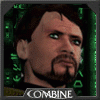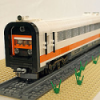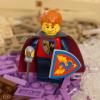Search the Community
Showing results for tags 'microscale'.
Found 216 results
-
Teensietown is a modular LEGO microscale city based on the "Micropolis" standard published by TwinLUG but with some slight amendments that suit us there and then better. It is a growing thing, and most impressive when exhibited. Anyone who cares to look more closely can find an old LEGOLAND-Set, as well as a model of the televisiontower of Prague. Everything else was built from inspiration and imagination. Here you can find a lot of the buildings extracted from the whole thing as well as info on the co-builders: http://teensietown.weebly.com/ Sherv, a fellow of my local LUG, has ignited the whole idea, I am responsible especially for the waterway management, and more recently railroads and highway. The easy thing with the project is for me, that one can build with the parts that one has and doesn't have to buy too much bricks to make it look good. Thanks to the modular system, the city looks different everytime it gets exposed. Some more pics can be found now and then at our LUG's forum (german) here: http://forum.lgoe.at...hp?topic=3563.0 Hope ya like it!
- 5 replies
-
- micropolis
- microscale
-
(and 3 more)
Tagged with:
-
Here’s something for the french friends here. I found it in wikipedia when looking up the architectural term "intersection" (german: Vierung), because Cluny had two of them. Once cluny has been the biggest christian church of the world. To put it to LEGO was not a big deal, since much everything has 90° angles, but the microscale-result is very satisfying, well at least for me.
-
I’d like to kick off with one of my (sort of) master pieces. At least some of my local LUG like it and it was displayed at our local LEGO store. It is a railway stop in Vienna, actually an underground-station of the line U6, but situated above floor level. The architect of the original building was Otto Wagner https://en.wikipedia...iki/Otto_Wagner, world famous for Art Nouveau (Jugendstil) in Vienna, Austria. It is my least „micro“-scale building I’ve ever built, the scale is approx. 1:100. I’ve tried to show as much detail as possible and it showcases each and every door and bench. Just in the wings I had to reduce the number of windows from 8 to 6, to keep the symmetry with the archs below. The roof rests like with the original building on the green stands, so they are functional even within my model. For the Nouveau-Art ornaments came mixel-teeth in quite usefully, as well as the round 1x1 mini-tiles. (klick to enlarge) Here’s a view into the building with the platform, therefor i removed the roof on one side. However, I did not add a train, because I’m more interested in architecture than in trains.
- 6 replies
-
- Microscale
- Architecture
-
(and 3 more)
Tagged with:
-
Hi everyone, although this site has EURO in its name i’m quite surprised to find so many here from all over the world, which makes the pleasure to join in even bigger. I’m from Austria, from the very heart of Europe and not to be mixed up with the land of kangoroos from downunder ;-) Austria is most famous for Mozart and the Blue Danube (which is not blue at all). I live, as one quarter of all Austrians in its capital, Vienna, where I am member of the local LUG „LGOe“. Our german-written homepage, which contains also a forum, would be www.lgoe.at. I’m in LEGO since childhood with the common long time of (nearly) not touching a brick until the day, when my boy set foot into our world (2008). Then I started to rebrick my old sets, but in the meantime, with all the new parts that have come with the new sets, I became a MOCer. My favorite subject when MOCing became Microscale, since I don’t have a house and space to keep parts and buildings is rare. When LEGO started the Architecture-Series I decided to turn Austrian buildings into LEGO-Microscale, I usually try to minimalize as small as I can without losing the things that make up the special approach of the original building. Thus I try to keep the proportions but overdo some important details - but you will find out yourself when i post the pictures. Another microscale I started together with another man of my LUG is a Microcaletown called Teensietown, which has indeed a spezial mix of scales but all together it looks quite pretty and it is growing exorbitantly fast. I’m a denier of most modern time tools and have neither accounts on facebook nor flickr. I will share my pics only in this forum or the one of my Austrian LUG. You may have noticed, that English is not my mother’s tongue. When writing in English I use to do it in a sometimes all too poetic style, so please accept the poetic license in my very words. Thanx!
- 5 replies
-
- Austria
- Microscale
-
(and 1 more)
Tagged with:
-
Interesting little experiment in which I tried to use one versatile frame and a not dissimilar amount of parts to make two quite different designs: -- AC-27 'Salamander' by TenorPenny, on Flickr AC-27 'Salamander' by TenorPenny, on Flickr AC-27 'Salamander' by TenorPenny, on Flickr Armoured Crawlers are a hybrid between traditional tracked tanks and the more modern bipedal walkers. They combine the sturdy armour of the former with the adaptability of the latter to create an affordable and stalwart part of any ground force. The 'Salamander' is a human vehicle, designed and marketed by the Northropp Terrestrial Division and supplied primarily to US forces. It is heavily armoured and capable of withstanding damage which would destroy other craft of it's stature. It's default armament takes the form of a anti-material cannon mounted on it's back. This weapon can target both ground and sub-orbital enemy targets at mid-to-long range. Salamanders are typical commandeered by Generals and other high-ranking individuals, placed at the core of a defensive formation or the rear of an attack. ---- FFG Gunboat by TenorPenny, on Flickr Designed for foreign military forces by American interests, the FFG (Forward Fire Gunboat) was marketed primarily at the Lonova. Although lacking in complex software and electronics, the FFG displayed impressive firepower for it's size and cost. Four forward-facing rocket pods are able to deal massive damage against slow-moving targets at short-range. This prosaic selling point managed to garner a large order from the fledgling Lonova military forces, in spite of it's vulnerability to more nimble starfighters and flak defence.
-
Helios-class CEV Helios-class CEV by TenorPenny, on Flickr Helios-class CEV by TenorPenny, on Flickr Combat Engineering has existed for almost as long as combat. As humans reached for the stars, the idea followed the along. The Helios-class was designed to support front line combat operations; it is able to jam enemy sensors, repair external damage and boost friendly shield levels. The pictured version belongs to the Sinistral, an independent group of scientists and researchers who hire out their abilities and experience to the highest bidder. Their combat engineering vessels are hardy enough to survive encounters with an enemy force; the SS version features enhanced jamming capabilities as well as micro-mine launchers to destroy or disable pursuing craft. Manufacturer: SynTech Role: Exploration, experimentation, combat engineering Crew: 2 Weaponry: 2 x Micro Mine Launchers Special: Enhanced scanners and combat engineering capability Armour/Shields: Medium/Medium More pictures: https://www.flickr.c...vanmunroerocks/
-
A difficult to complete MOC, directly inspired by the French Sillage comics from Jean-David Morvan & Philippe Buchet. Here is the original drawing that was my inspiration source: Erradikor 7 - Original Drawing by Veynom, on Flickr It took me several days to start with the hull (for which I applied a classic space pattern) but then it took me several weeks to complete the model. I wasted a few more weeks just to take some pictures of it manily because it was built during winter and I wanted some decent light. The model is too large for my small photo studio or maybe my photo studio is too small. In the end it still took me a few more weeks just to start with the necessary picture editing but ultimately, here it is. Long and hard work but not too bad as a result I particularly enjoyed the truly atypical hull shape of that little beast measuring 80cm long. Thanks to these 80cm (and that little s2S antenna), it can proudly enter the S.H.I.P. category. Conquistador-class Star Destroyer Erradikor 7 by Veynom, on Flickr s2S stands for "ship to S.H.I.P." ;) The Erradikor 7 in action: Erradikor 7 in Space by Veynom, on Flickr Sitting on its display stand: Conquistador-class Star Destroyer Erradikor 7 by Veynom, on Flickr Conquistador-class Star Destroyer Erradikor 7 by Veynom, on Flickr It was a not so easy greebling exercise of all kind on each side, without even talking about the numerous antennas, arms, and other pitots. Conquistador-class Star Destroyer Erradikor 7 by Veynom, on Flickr The front view clearly emphasise the two-headed front part of the monster. This was clearly my favourite part in this design. A few close-ups: Erradikor 7 - Underside close-up by Veynom, on Flickr Erradikor 7 - Underside by Veynom, on Flickr Erradikor 7 - Main body top view by Veynom, on Flickr Erradikor 7 - Main body upper view by Veynom, on Flickr Erradikor 7 - Rear view by Veynom, on Flickr Some picture editing tentatives:. Erradikor 7 in a mission by Veynom, on Flickr Erradikor 7 is destroyed by Veynom, on Flickr Sadly, you will not get the chance to see it for real as it already returned to a pile of bricks.
- 10 replies
-
- SHIP
- classic space
-
(and 1 more)
Tagged with:
-
Bremen-class Corvette The Bremen-class Corvette was the first European Union combat capital ship produced following the Pan-Eurasian War. The outdated Union navy had been bested and embarrassed by modern mercenary forces. Following the armistice at the end of the conflict, Union admirals demanded comparable vessels and the versatile Bremen was the first to make it from blueprint to production. She is designed to shield and protect larger ships from warheads, fighters and other nimble threats. Computer-assisted flak turrets cover multiple vectors and Bremen crews pride themselves on their accuracy and kill counts. She also packs something of a wallop – a triple barrelled cannon is placed on the foredeck. Shipsmiths added the almost oversized weapon to give the Bremen bite when engaging ships of similar size up to destroyer tonnage. Suffice to say, the ship exceeded original expectations. Not only was it a more than adequate escort ship, it was also suited to operate on the borders of known space and respond quickly to myriad threats, from pirate attacks to Wun’Tux raiders. Manufacturer: Rheinmetall Industries Role: Escort, picket duty, border patrol Length: 60m Crew: 41 Weaponry: 1 x STS-Cannon (triple-barrelled, deck mounted) 4 x Flak Turrets (computer-assisted) [*] Shields/Armour: Medium/Medium [*] FTL: Capable
-
CV-17 Tiburon The Tiburon-class Corvette the capital ship workhorse of the Gnobo League. Similar to corvettes belonging to other races and groups, the Tiburon’s main role is to escort and protect larger ships. The Gnobo ship is remarkable in that it features zero point defence weaponry; it’s offensive capabilities centre around a pair of double-barrelled particle cannons. The ship typifies the gun-ho Gnobo tactical approach. There is no finesse in it’s electronic systems, it’s shields are strictly average. These are not features the shipwrights prioritise. Instead, reinforced bulkhead and integrated armour plates mean the Tiburon is built to take a beating. This means the Tiburon can go head-to-head with frigates and destroyers and come out the other side in one piece. It’s obvious vulnerability is to enemy fightercraft, so the Gnobo mercenary brigades usually field the ship with an escort of Gun Skiffs. This Tiburon-Skiff combination is the most affordable option to most people looking to buy Gnobo assistance; it is not uncommon to see these corvettes fighting against each other on behalf of their respective employers, such is their prevalence. Manufacturer: Various Gnobo Shipwrights Role: Ship-to-ship assault, escort Length: 46m Crew: 19 Weaponry: 2 x Particle Cannons (double-barrelled, turreted) Shields/Armour: Light/Heavy FTL: Capable
-
Hello, This is a MOC I made as a contest entry for a challenge our LUG had at a show to use only one colour. It's supposed to be the acropolis in Greece. : ) Micro Acropolis by Trent, on Flickr Micro Acropolis II by Trent, on Flickr
-
On May 4th we startet a contest in our Star Wars LUG ImperiumderSteine.de asking for MOCs based on what we've seen from Episode VII so far. I never though I'd enter, I'm finishing college in three weeks and with assignments and hand-ins and all time was sparse. I couldn't stop thinking about it though and I wanted to prove that you need no Episode VII minifigures to do something cool. I also had to prove wrong some friends of mine that complained that I never do Star Wars creations I'd like to present a garrison of Episode VII stormtroopers rallying in front of the iconic banner of the First Order on some outpost in the snow: I'd like to thank Ryan / Eldeeem for the hexagon design he posted on flickr years ago that I used as a base for the banner. I hope you like it. Looking forward to your comments and criticism! Best Markus
- 9 replies
-
- Episode VII
- First Order
-
(and 2 more)
Tagged with:
-
Here we have a few microscale locomotives. They include the iconic Thomas The Tank Engine and his friend Percy. Also included is a BNSF locomotive with freight train and a Santa Fe Passenger. BNSF freight Subway and City Thomas and Percy Random Train Santa Fe Train An overview of all of the models
-
Hi to all, I have the pleasure to present 3 of my latest MOCs. 3 iconic building of Madrid. TORRESPAÑA (PIRULI) Torrespaña (literally "Spain Tower") is a 231 m (757.87 ft) steel-and-concrete television tower located in Madrid, Spain. National terrestrial television channels RTVE, Telecinco andAntena 3, as well as the autonomic channel Telemadrid, along with a few radio stations, broadcast from the tower. The tower was built in 1982, commemorating the FIFA World Cup celebrated in Spain that year. The building was administered by RTVE until 1989, when control over radio and television emissions in Spanish territory was given to Retevisión. It is not open for tourists. The Torrespaña tower is generally known in Madrid as the "Pirulí", given the similarity between the tower and a particular type of lollipop of conical shape very popular in Spain in the eighties. It is located in a depression, next to the M30 highway. Most of central Madrid lies to the W and NW. According to Google Earth, the terrain altitude at the site is 660 m (2,170 ft) whereas about 1 km (3,280.8 ft) to the NW it is about 700 m (2,296.6 ft) and rises to 720 m (2,360 ft) even further north. Add about 20–30 m (66–98 ft) height for the average building and the base of the tower is about 60 to 90 m (200 to 300 ft) below the rooftops in that area. The top of the tower is directly visible from most rooftops of Madrid, but it initially was thought and built to enhance television coverage in Southern Madrid. All pictures in full resolution TORRE PICASSO Torre Picasso (Picasso Tower) is a skyscraper in Madrid, Spain designed by Minoru Yamasaki. From 1988 until 2007 it was the tallest building in Madrid, measuring 515 ft (157 m) and with 43 floors. Torre Picasso is located next to the Pablo Picasso Square, within the commercial complex AZCA along the Paseo de la Castellana. At its opening in 1988, Torre Picasso was surpassing the elder office tower Torre de Madrid. However, it was not Madrid's tallest building, as the television tower Torrespañacompleted in 1982, was higher with its 231 m (757.87 ft). Notable surrounding skyscrapers are Torre Europa, Banco de Bilbao Tower and Windsor Tower, now demolished after a fire. The Torre Picasso was Spain's tallest building until 2001,when it was overtaken by the Gran Hotel Bali in Benidorm, Alicante,the Torre Espacio in 2007,and Torre Caja Madrid, Torre de Cristal and Torre Sacyr Vallehermoso since 2009. All pictures in full resolution ATOCHA STATION Madrid Atocha (Spanish: Estación de Madrid Atocha, also named Madrid Puerta de Atocha) is the largest railway station in Madrid. It is the primary station serving commuter trains (Cercanías), intercity and regional trains from the south, and the AVE high speed trains from Barcelona (Catalonia), Zaragoza (Aragon), Seville (Andalusia) and Valencia(Levante Region). These train services are run by the Spanish national rail company, Renfe. The station is in the Atocha neighborhood of the district of Arganzuela. The original façade faces the Plaza del Emperador Carlos V, a site at which a variety of streets converge, including the Calle de Atocha, Paseo del Prado, Paseo de la Infanta Isabel, Avenida de la Ciudad de Barcelona, Calle de Méndez Álvaro, Paseo de las Delicias, Paseo de Santa María de la Cabeza, and Ronda de Atocha. The Atocha station is really a railway complex, formed by the Madrid Atocha Cercanías and Madrid Puerta de Atocha stations of the Spanish national railways and the Atocha Renfe station of the Madrid underground. At this site, Madrid's first railway station was inaugurated on 9 February 1851 under the name Estación de Mediodía (Atocha-Mediodía is now the name of an area of the Arganzuela district, and means south in old Spanish). After the building was largely destroyed by fire, it was rebuilt and reopened in 1892. The architect for the replacement, in a wrought ironrenewal style was Alberto de Palacio Elissagne, who collaborated with Gustave Eiffel. Engineer Henry Saint James also took part in the project. The name Atocha has become attached to the station because of the nearby basilica dedicated to Our Lady of Atocha. The train platforms were partly covered by a roof in the form of inverted hull with a height of approximately 27 meters and length of 157 meters. The steel and glass roof spreads between two brick flanking buildings. This complex of railway tracks expanded through the years. In 1985, a project of complete remodeling began, based on designs byRafael Moneo. In 1992, the original building was taken out of service as a terminal, and converted into a concourse with shops, cafés, and a nightclub. Like the Orsay Museum in Paris, the concourse has been given a new function, this time a stunning 4,000 m2(43,056 sq ft) covered tropical garden. A modern terminal was also designed by Moneo, and built in adjacent land to serve both the new AVE trains and local commuter lines. The main lines end in the new terminal; commuter train platforms are located underground, at the ingress to a rail tunnel extending northward under the Paseo de la Castellana. The station is served by two Madrid Metro stations, Atocha and Atocha Renfe. The latter was added when the new terminal building was constructed and is directly linked to the railway station. All pictures in full resolution Enjoy it
- 5 replies
-
- Architecture
- madrid
-
(and 2 more)
Tagged with:
-
Washburn Washburn is the US capital city of New Kansas, Kepler System. True to it’s namesake, New Kansas is a fertile farming world from which a wide variety of crops are cultivated and animals raised. Settlements range from small, old fashioned farms to large, mechanised outposts of synchronised machines and technology. Typical Washburn city block, complete with florist, house, bridge and traffic. Washburn is the hub for all manner of activity; business, education and pleasure. It is the port by which New Kansas feeds a large proportion of the Core Worlds. The city is home to several of the top biochemical and veterinary colleges of their kind. A giant spaceport sits on the outskirts of the city, big enough to accommodate the larger interplanetary barges for the transfer of crops and livestock. There is also quite the lively nightlife; most of these bars and cantinas centre around the American Cool Revival trend. They feature music and décor reminiscent of American days gone by. There exists a quiet acrimony the settlers who reside solely within Washburn and the more isolated farmers. The latter consider their city-based fellows stuck-up and pretentious. The former consider the farming population crass and uncultured. Above: a typical Washburn home The city is home to the New Kansas Senator, when she is not involved in democratic discussions back on Earth. Although officially neutral during the Pan-Eurasian War, several of the large farmers sold food to the under-siege Coalitionpopulation of Kepler II. One side of the story paints the farmers as saving the lives of starving children. The reality was that rich agricultural groups made huge profits breaking a neutrality clause set by the government. The US investigation into the food smuggling found no person or organisation culpable is considered a whitewash by the Coalition.
- 6 replies
-
- lego
- microspace
-
(and 2 more)
Tagged with:
-
Amani Nocosta The Amani have no organised military, no true warships. Their vessels are built to protect the families who serve upon them. The Nocosta is the smallest known Amani vessel and serves as a scout, shuttle and deep space mining platform. It is built to stand up to the rigours of such a dangerous industry: heavy armour plates and strong heat shielding. The fusion cannons above and below the cockpit are primarily used to break up deposits of valuable minerals. However, the galaxy is full of hazards both natural and sentient. The Nocosta also serves at the first line of defence of any Amani caravan. It is manoeuvrable enough to trouble opposition fighters and sturdy enough to go toe-to-toe with the smaller grade of capital ship. It’s flexibility is, however, also it’s weakness. The ship suffers against masses of nimble fighters. It is often not quite fast enough to evade the heavy weapons of larger ships. However, the crews of the Nocosta fight for not a cause or a faction but for their lives. They are hard targets to attack and many a pirate has learnt this the hard way. Manufacturer: Amani Forgeworks Role: Scout, shuttle, mining vessel. Length: 22m Crew: 3. Passengers: 10 Weaponry: 2 x fusion cannons Shields/Armour: Medium/Heavy FTL: Capable.
-
"We count 30 rebel ships, Lord Vader, but they're so small they're evading our turbolasers." "- Biggs, Wedge, let's close it up. We're going in full throttle. That ought to keep those fighters off our back. - Right with you boss." The theme of the Death Star attack has been banged on about by AFOLs. Fortunately, this does not mean, that the subject is exhausted. It took a bit different approach than the usual <middle of the trench – accelerating Luke’s X-Wing – T/F vee in hot pursuit> and to give the scene a bit more dramaturgy. For that reason, the DS’s equator does not run at the right angle through the MOC, and we have a small anti-aircraft (anti-starship) artillery barrage. The MOC is placed on a standard 48x48 board and consists of four main modules: The base with decorative boarder; The trench itself with the walls; Two loosely put on DS surface panels. Plus additional X-Wing fighters of course :). What I really wanted in this microscale MOC, was a good representation of the X-Wings. That is why they have their characteristic feature of folded (and movable) wings. The drawback is a slight asymmetrically placed left and right pairs of wings and engines. Also, I am not entirely pleased with the fuselage in front of the fairings. But at least all have R2 units… Also the scale of the DS denoted that the Rebellion fighters were too big for the trench itself. That is why, with their measurements of 9 studs width and 6 length, they had to be left on the battle station’s surface. To make the scene complete, six rotary turbolasers are placed, “some on the towers, some on the surface”, which try in vain to stop the attackers. And a small comparison of the adversaries: As I always lack the trans-clear elements, especially the bars (which also usually fell down on my Bricklink buy lists…), I had to devise a different solution to the issue of placing flying objects. It came in the form of optic fibers. Thanks to their flexibility, i was able to place them in possibly invisible way on the maquette (part of the element is folded and hidden in base elements) and, having only three pieces, by folding one into ”U”, place all in all four flying objects. Unfortunately, this advantage proved also to be a vice – too long segment meant weak stabilization power and “floating” of the raised item. And stiffening with super glue was out of the question. Entire gallery on Flickr. May the micro-Force be with you!
- 13 replies
-
- death star
- microscale
-
(and 1 more)
Tagged with:
-
Blackfin The Blackfin is the first ‘crew-lite’ ship put into service by the Hirudin. Named after a ferocious carnivore of the Hirudin homeworld which was for hundreds of years the apex predator; until the Hirudin gained their powers of manipulation and brought it under their control. The Blackfin is designed to be swift and deadly; able to operate independently and mostly undetected until it decides to reveal itself. This stealth is achieved via technology and tactics; clever ECM and sensor-ghost shadows forming the cornerstone of ship systems. The subset of Trinaxenslaved by the Hirudin are viewed as cowardly thralls by their masters; it’s true that they have little stomach for battle and will flee at the first hint of defeat. The Blackfin is unique in that it features a collective of Hirudin – usually 4 or 5 individuals – as it’s captain. They control ship systems centrally via an advanced neuro-techno interface; any manual labour is performed by on-board drones. These robots require no life support, meaning the ship can prioritise other systems. Blackfins are the smaller end of capital-scale, technically, but operate more like their namesakes than naval assets. Sometimes they stalk prey alone from the safety of their sensor-shadows. Sometimes they work in packs to track and trap convoys of precious cargo. The mere threat of Blackfin attack is enough to make a seasoned merchant panic; the ship’s name is spoken with hushed tones. Hirudin – like the Wun’Tux – have no formal peace treaties with any species. They are known to probe and test at the border shared with the European Union colony worlds. The Blackfins avoid formal combat and instead sneak around, engaging isolated ships when conditions favour them. The axillary pre-War warships of the Union lack sufficiently clever and advanced sensors and fire control to hit the Blackfin very easily and several of the Cassardclass have been crippled in such an engagement. The newer Union ships have turned the tide against these insidious invaders, using advanced fire control and detection to track and outfox the Hirudin. The ship’s flaws are not difficult to discern; her weaponry is potent, but short range and unsuitable for prolonged engagements. Aside from it’s ECM and stealth abilities, it has little protection from fightercraft. What armour it has is angled to deflect enemy sensors and integrity suffers accordingly. Additionally, due to their insistence on ‘seeing’ space, the Hirudin ship masters’ bridge is visible on the surface of the vessel. It is made of a transparent metal alloy but remains vulnerable. “Smash the fish bowl, win a prize,” is a Union Navy jape frequently used.
-
Gnobo Gun Skiff by TenorPenny, on Flickr More available here. he S-91 is the most widely produced of the GnoboGun Skiffs; filling the operational role of fightercraft, assault shuttle and ground attack vehicle (amongst others). It’s distinctive profile – two horns meeting a central body – makes for an instantly recognisable silhouette. The shape isn’t only for show: these two ‘horns’ bracket the landing ramp, meaning armed Gnobo infantry can quickly exit the ship under cover from both sides. The Gnobo mercenary brigades are famously rugged and hard to break down. If their large ships and infantry form the structure, the S-91 is the glue that holds it all together. It’s first role is that of a fighter. It is big and unwieldy by the standards of humans; who tend to rely heavily on a mix of different fighter types. It tends to suffer when pitted against more agile opponents, but it’s thick hide and potent armament gives it a competitive edge. It’s ability to travel Faster-Than-Light also grants a tactical advantage; akin to that of the human strike fighter. It also serves as an armoured shuttle for VIPs and infantry; it’s reputation for difficult landings and extractions is legendary. The Gnobo homeworld is mountainous and perilous; their warriors train on the most hazardous terrain that other races might consider near vertical and impossible to traverse, nevermind fight on. S-91 pilots are disciplined enough to drop and collect their soldiers on such terrain. It’s final role is that of a ground attack craft. Accurate terrain assault is a relative breeze compared to the difficulty faced in deploying soldiers in hazardous atmospheric conditions. It’s armamentof fragmentation cannons and multi-warhead missiles means it can cause chaos across large swathes of enemy terrain, disrupting industry and troop formations alike. It’s thick armour hide means it can shrug off a certain amount of anti-aircraft fire, too. A standard S-91 mission might be to deploy troops strategically and then support them from the air, but it can be seen throughout Gnobo tactical deployment. Length: 17m Manufacturer: GNSW Role: Fightercraft, Shuttle, Ground Attack. Crew: 4 Weaponry: – 3 x Fragmentation Cannons (forward firing) – 2 x Warhead launchers Armour/Shields: Heavy/Medium
-
Hi everybody! I'd like to show you my latest mini-moc. It try to represent the Space Shuttle in its most exiting moment: the launch to the space. Hope you like it: Other pictures: http://www.mocpages.com/moc.php/405011 Ideas: https://ideas.lego.com/projects/92515 Any comment or suggestion is welcome! Bye Teazza
- 12 replies
-
- microscale
- space
-
(and 3 more)
Tagged with:
-
Last March (2014) I tore down Brickville for several reasons. I then started Brick City which is roughly twice the scale of the previous city. Currently there are 54 baseplates (48 pictures above) and about 32,000 pieces. Hopefully this one lasts longer than three years! See more on Flickr: https://www.flickr.com/photos/brickville/with/14869472851/
- 9 replies
-
- Brick City
- Brickville
-
(and 3 more)
Tagged with:
-
Hello Everybody! About 2,5 years ago I created my last (classical) LEGO Architecture model. Inspired by the inclusion of my MetLife Building model in Mike Doyle's Beautiful LEGO 2, I finally executed another architecture MOC. For sure the great reference of Spencer_R was an inspiration as well. Here is my execution of Chicago's Lake Point Tower: Find more pictures on my flickr photostream and feel free to leave your comments! Thx & so long, Jens
- 6 replies
-
- LEGO
- LEGO Architecture
-
(and 3 more)
Tagged with:
-
SVERDLOVSK '86 In 1986, the confrontation between the two superpowers reached its climax and turned into the third world war. Nuclear strike razed to the ground dozens of major cities on the continents turning them into a lifeless desert. Millions of tons of radioactive dust raised into the air by the powerful explosions that led to large-scale environmental disaster. The remnants of humanity were thrown back in the development for centuries, and leading a losing battle for survival. Spiral of evolution on Earth has completed its turn and start a new one ... One of the places where you can meet the survivors became Sverdlovsk. This city with a million people was once the main administrative, industrial and cultural center of the Urals. Perhaps being in the interior of the continent away from the object of the main attack saved it. SVERDLOVSK by vir-a-cocha, on Flickr A handful of survivors settled on the right bank of the dry river Iset in the former building of the circus. The unique design of the dome withstood the shock wave. A second preserved building is unfinished TV Tower maden from the heavy-duty concrete. It was not finished in time of peace, and construction stopped at around 219m. SVERDLOVSKby vir-a-cocha, on Flickr Now, it's just concrete structures buried under the dust . The right bank of the Iset River, between the streets of Kuybysheva, 8-go Marta and the Dekabristov, and all the buildings are made in the scale of 1:2000. (geotaged) SVERDLOVSK by vir-a-cocha, on Flickr Somewhere in another reality ... In 1986, a meeting of Gorbachev and Reagan in Reykjavik, which marked the beginning of a new foreign policy of the USSR. From this moment the relations between the countries have warmed. In Soviet Union Perestroika has began, then another serie of events occured during which the Soviet Union ceases to exist. Sverdlovsk in 1991, was renamed into Ekaterinburg. Circus, located on the corner of Kuibysheva Str and March 8 Str, continues to delight children and their parents. The famous TV tower was never completed. After 1989 began construction financing shortages, and it was frozen. In 90s the tower was a popular place for suicides, adventurers, climbers and BASE jumpers. After a series of resonant accidents access to it was closed. Video aerial view shows the beauty of the center of modern Ekaterinburg. youtu.be/PoWjtfDNAB0
- 1 reply
-
- Microscale
- Architecture
-
(and 2 more)
Tagged with:
-
My first experiment with a microscale city themed build.
-
Hi guys, my name is Swamp and I'm here to present you a, well, micro scale castle made in LDD. It's my first try in this so I'd appriciate critique.












